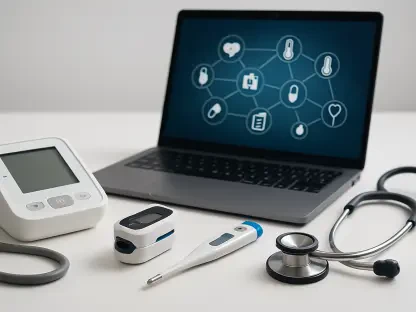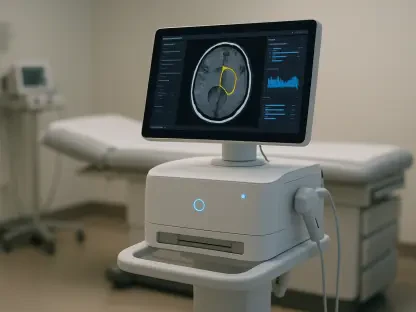Imagine a world where medical professionals can look deep inside the human body with such precision that hidden diseases are detected in record time, all while minimizing risks to patients and transforming diagnostic capabilities. This vision is inching closer to reality with the development of a groundbreaking technology known as the Perovskite Camera. Born from a collaborative effort between Northwestern University in the U.S. and Soochow University in China, this innovative device harnesses the unique properties of perovskite crystals to detect gamma rays with extraordinary accuracy. Highlighted in recent scientific discussions, this advancement holds the potential to transform Single-Photon Emission Computed Tomography (SPECT) scans, a cornerstone of nuclear medicine. By offering clearer images at a significantly lower cost than current methods, the technology could redefine how internal functions like heart activity and blood flow are visualized. The implications for healthcare are immense, promising faster diagnostics and broader access to cutting-edge tools. But what sets this invention apart, and can it truly change the landscape of medical imaging?
Unveiling the Science Behind Perovskite Innovation
The foundation of this remarkable technology lies in perovskite crystals, a material previously celebrated for its impact on solar energy solutions. These crystals have now been adapted for medical imaging, demonstrating an ability to detect individual gamma rays with a level of clarity that surpasses traditional detectors made from cadmium zinc telluride (CZT) and sodium iodide (NaI). Engineered into pixelated sensors, much like the tiny components in a smartphone camera, these crystals deliver unprecedented energy resolution in SPECT scans. This allows for the capture of minute details that were once obscured, providing a window into the body’s inner workings with stunning precision. The potential to distinguish even the faintest radioactive signals, such as those emitted by clinical tracers like technetium-99m, marks a significant leap forward in diagnostic imaging capabilities, setting a new benchmark for what’s possible in nuclear medicine.
This breakthrough is the result of years of dedicated research by teams led by Mercouri Kanatzidis at Northwestern University and Yihui He at Soochow University. Their painstaking process of growing, shaping, and refining perovskite crystals into functional detectors showcases a blend of scientific ingenuity and technical expertise. The journey has involved overcoming numerous challenges to ensure the material’s stability and sensitivity under the demanding conditions of gamma-ray detection. What stands out is the adaptability of perovskites, transitioning from energy applications to a pivotal role in healthcare. Their work not only highlights the versatility of this material but also underscores the importance of international collaboration in pushing the boundaries of medical technology, paving the way for tools that could soon become standard in hospitals around the globe.
Addressing Shortcomings of Existing Imaging Systems
Current SPECT detectors, while instrumental in modern diagnostics, are plagued by significant limitations that hinder their widespread use. Detectors made from cadmium zinc telluride (CZT) offer decent performance but come with a staggering price tag, often ranging from hundreds of thousands to millions of dollars per camera. Their brittle nature further complicates manufacturing, driving up costs and limiting scalability. Meanwhile, sodium iodide (NaI) detectors, although more affordable, are cumbersome and produce images with poor resolution, often likened to looking through a clouded lens. These drawbacks create a pressing need for an alternative that balances cost, ease of production, and image quality. Without such a solution, many healthcare facilities struggle to provide advanced diagnostics, leaving patients with longer wait times and less reliable results.
Enter the Perovskite Camera, which emerges as a promising answer to these persistent challenges. By leveraging less expensive materials and simpler production methods, this technology slashes the financial burden associated with high-end imaging systems. Its superior performance, characterized by sharper images and greater sensitivity, addresses the technical shortcomings of both CZT and NaI detectors. This could fundamentally alter the economics of medical imaging, ensuring that smaller or underfunded hospitals are no longer excluded from offering top-tier diagnostic services. The ripple effect might extend to rural and developing regions, where access to such equipment has historically been limited, potentially narrowing the gap in healthcare quality across different geographies and socioeconomic conditions.
Enhancing Patient Outcomes and Healthcare Access
From a patient’s perspective, the introduction of the Perovskite Camera could herald a new era of comfort and safety during diagnostic procedures. Traditional SPECT scans often require lengthy durations, exposing individuals to higher levels of radiation and increasing both physical discomfort and anxiety. With this new technology, scan times are expected to shrink significantly while radiation doses are minimized, easing the burden on those undergoing testing. More importantly, the enhanced clarity of images produced by perovskite detectors means that conditions such as tumors or cardiovascular issues can be identified with greater certainty. This precision translates to quicker, more accurate diagnoses, enabling medical teams to devise effective treatment plans sooner and improving overall health outcomes for countless individuals.
Beyond individual benefits, the broader impact on healthcare systems could be transformative due to the affordability of this innovation. The reduced cost of perovskite-based detectors opens the door for more clinics and hospitals worldwide to adopt advanced imaging technology, breaking down barriers that have long restricted access to well-resourced facilities. This democratization aligns with a growing movement to ensure that cutting-edge medical tools are not a luxury reserved for affluent regions but a standard available to all. Such a shift could redefine global healthcare equity, allowing under-resourced areas to offer the same level of diagnostic capability as major medical centers. The potential to save lives through earlier detection and intervention, regardless of a patient’s location or economic status, underscores the profound societal value of this technological advancement.
Navigating the Path to Widespread Adoption
While the promise of the Perovskite Camera is undeniable, the journey from laboratory success to clinical implementation presents several hurdles that must be addressed. Scaling production to meet the demands of a global healthcare market remains a critical challenge, as does ensuring the technology integrates seamlessly with existing medical systems. Regulatory approvals, quality control standards, and compatibility with current hospital infrastructure are all factors that require careful consideration. Additionally, training medical staff to operate and interpret results from this novel equipment will be essential to maximize its benefits. These logistical and practical aspects, though surmountable, highlight the complexity of translating cutting-edge research into everyday medical practice.
Looking ahead, the commercialization efforts spearheaded by entities like Northwestern’s spinout company, Actinia Inc., signal a strong commitment to bringing this technology to market. Partnerships with medical device manufacturers are already in motion to facilitate integration into hospital settings. Ongoing research also points to opportunities for further refinement, such as enhancing detector durability and exploring additional applications in medical imaging. The cautious optimism surrounding these developments suggests that while immediate widespread adoption may take time, the groundwork is being laid for a future where perovskite-based systems become a cornerstone of nuclear medicine. If these efforts succeed, the impact could extend beyond diagnostics, potentially influencing other areas of healthcare technology over the coming years.
Reflecting on a Milestone in Medical Progress
Looking back, the emergence of the Perovskite Camera stood as a defining moment in the evolution of nuclear medicine. Its ability to deliver superior image resolution and sensitivity compared to conventional detectors marked a significant triumph over longstanding technological barriers. The collaborative spirit between institutions in the U.S. and China, combined with a vision for affordable healthcare solutions, drove this innovation to new heights. Patients benefited from safer, faster scans, while hospitals gained access to tools that were once financially out of reach. As efforts to refine and scale this technology unfolded, the focus shifted to actionable next steps—streamlining production, securing regulatory endorsements, and training healthcare providers. The path forward promised not just to enhance diagnostic capabilities but to inspire further exploration into how versatile materials like perovskites could address other pressing challenges in medicine, setting a precedent for future breakthroughs.









